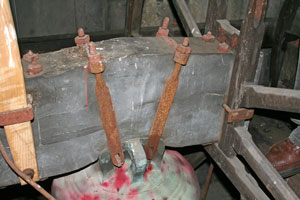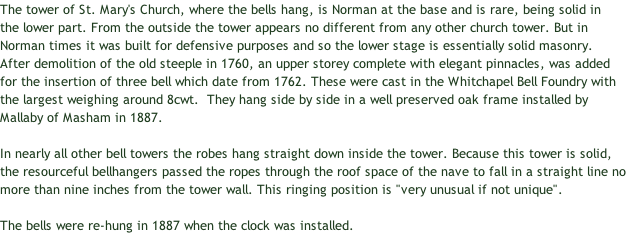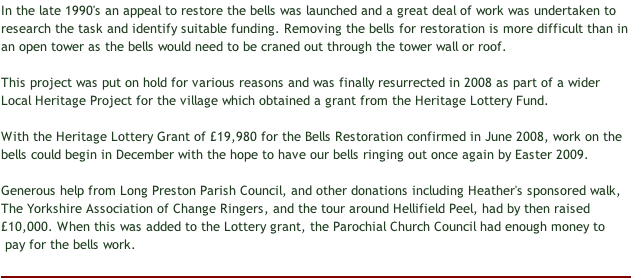


Every person in England is familiar with the sound of church bells. Whether it’s bells being rung in the local village or city church or bells being heard on television during Royal or State occasions, everyone knows what the sound is. It’s part of English culture and it’s only done in England, plus a little in the other parts of the British Isles and in countries such as Australia and the USA, which have a strong English background.
The bells do not ring tunes, nor is one person sounding many bells, as happens in other parts of the world. Here, each bell has its own ringer and the ‘pattern’ of sound produced is known as change-
Bells have a religious dimension to them as well. In the 17th and 18th Centuries, when virtually everyone went to church every Sunday -
I suppose it’s not universally known that church bells rotate in a full circle when they’re rung, first one way and then the other. To enable them to do this they have to be built into a church tower like a piece of heavy machinery.
The crowns of the bells have to be fastened to large blocks of timber or steel (headstocks), which themselves have axles protruding from their ends which sit into bearings, to enable the bells to turn.


( The red marks seen on the bells is from the die used to detect the cracks. )
The whole ensemble has to be mounted in a substantial wooden or steel frame to take the force of the rotating bells. The frame then has to be securely built into the tower walls. The bells are ‘controlled’ by the ringers by ropes fitting into a groove on the outside of large wheels fastened to the headstocks.
The technology of bell hanging has hardly changed since the 18th century and this is what we have in St. Mary’s church, with our three bells weighing over a ton altogether. We have however a layout of the machinery which is probably unique. The tower is not an open structure down which the bell ropes can hang, as is usual. It’s essentially a solid structure with a spiral staircase built inside it. As a result, the bell ropes have to fall into the church nave, close by the wall.
The centuries have taken their toll, as they do with any machinery. Two bells now have short, hairline cracks in their crowns, resulting from the old-
The big question was ‘where do we get the money from?’ Long Preston Parish Council came up trumps as soon as it knew one of the village’s gems was in danger of becoming derelict and various parishioners contributed very generously. But it still left us some tens of thousands of pounds short. We had to approach national charities for the outstanding money.
In the end, the Parochial Church Council (PCC) applied to five charities; some were not forthcoming, whilst others gave token amounts. We therefore put our major efforts into a bid to The Heritage Lottery Fund, which, because of its nature (as its title indicates) will only support bids with a big heritage aspect. A group of parishioners who were interested in exploring the history of the village came to the rescue and joined their plans to the bid, thus giving it much of the heritage strength required. As everyone knows, the bid was thankfully successful.
As a measure of the bureaucracy to date, we’ve had eight visits to the church by various bellhanging firms and structural engineers, we’ve had to consult English Heritage, the Council for the Care of Churches, the Society for the Protection of Ancient Buildings, the Yorkshire Dales National Park Authority, an Archaeologist and the Bradford Diocese’s Advisory Committee, several of which made their own visits. The Diocese has now givien us the formal Faculty to get on with the work.
The bids to the charities were very time-
And that’s not the end. In accepting the HLF grant, the PCC has had to enter a legal agreement, which is itself a half-
Robert Cater -






